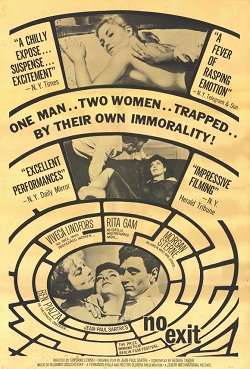No Exit (1962 film)
No Exit, also known as Sinners Go to Hell,[1] is a 1962 American-Argentine dramatic film adaptation of Jean-Paul Sartre's play No Exit directed by Tad Danielewski. The film stars Morgan Sterne, Viveca Lindfors and Rita Gam.
| No Exit | |
|---|---|
 Theatrical release poster | |
| Directed by | Tad Danielewski |
| Produced by | Fernando Ayala Héctor Olivera |
| Screenplay by | George Tabori Orson Welles (uncredited) |
| Based on | No Exit by Jean-Paul Sartre |
| Starring | Morgan Sterne Viveca Lindfors Rita Gam |
| Music by | Vladimir Ussachevsky |
| Cinematography | Ricardo Younis |
| Edited by | Jacques Bart Carl Lerner Atilio Rinaldi |
Production company | Aries Cinematográfica Argentina |
| Distributed by | Zenith International Films |
Release date |
|
Running time | 85 minutes |
| Country | United States Argentina |
| Language | English |
Plot
The Valet (Manuel Rosón) enters a hotel room with Joseph Garcin (Morgan Sterne) in tow. The windowless room has a single entrance and no mirrors. Two women, Inès Serrano (Viveca Lindfors) and Estelle Rigault (Rita Gam), are then led in; afterwards, the Valet leaves and locks the door. Realizing that they are in hell, the trio expects to be tortured; however, no torturer is forthcoming. While waiting, they strike up a conversation and discuss each other's sins, desires, and unpleasant memories; they slowly realize that such probing is the form of torture they are meant to receive.
It later becomes apparent that Joseph, once a journalist, was executed for cowardice and the betrayal of the French Resistance. Estelle, who has a voracious sexual appetite, was a gold digger and seductress who killed a man. Meanwhile, the lesbian Inès abused her partner's love for her and eventually killed them both in a murder-suicide. As the story progresses, Garcin becomes increasingly annoyed by Inès' considering him a coward, while Estelle makes unreciprocated advances on him; Inès is tempted by Estelle, but crazed by Estelle's heterosexuality.
The three at first continue to see events happening on Earth, but eventually, as the living move on, they are left with only their own thoughts and the company of the other two. Towards the end of the film, Garcin demands he be let out; in response, the door opens. However, none leave. They resign themselves to their fate.
Production
Sartre did not know about the film while it was in production.[2] Viveca Lindfors, at the time married to screenwriter George Tabori, was chosen to play Inès.[3]
Style
The film uses dialogue-free flashbacks when the main characters talk about their lives.[4] Alison Darren in the Lesbian Film Guide notes that Inès is a "typical screen lesbian" of the early 1960s, both physically attractive and inherently evil.[5]
Release and reception
After being screened at the 12th Berlin International Film Festival in June 1962, where Rita Gam and Viveca Lindfors shared the Silver Bear for Best Actress award,[6] No Exit received its American release on December 5.[1]
Bosley Crowther, writing for The New York Times, found the film "antiseptic", with emotionless acting and stagy directing; he summarized that the film "prove[d] that "No Exit" is inappropriate material for a full-length [film]".[4] Allison Darren calls the film an "excellent psychological drama" with a "surprisingly overt" depiction of lesbianism.[5]
See also
- Huis clos (1954)
References
- IMDB, Sinners Go to Hell.
- Contat & Rybalka 1974, p. 612.
- Feinberg 1999, p. 20.
- Crowther 1962, Gay Purr-ee (1962).
- Darren 2000, p. 152.
- BIFF, Berlinale 1962: Prize.
Bibliography
- "Berlinale 1962: Prize Winners". berlinale.de. Archived from the original on January 14, 2012. Retrieved January 14, 2012.
- Contat, Michel; Rybalka, Michel (1974). The Writings of Jean-Paul Sartre. Northwestern University Studies in Phenomenology & Existential Philosophy. Evanston: Northwestern University Press. ISBN 978-0-8101-0439-6.CS1 maint: ref=harv (link)
- Crowther, Bosley (December 6, 1962). "Gay Purr-ee (1962) Screen: Sartre's 'No Exit' in Premiere at Sutton:His One-Act Play Was Adapted by Tabori Three Other Pictures Have Openings. 'Gay Purr--ee' Cartoon". The New York Times. Archived from the original on February 18, 2012. Retrieved January 29, 2017.
- Darren, Alison (2000). Lesbian Film Guide. New York: Cassell. ISBN 978-0-304-33376-9.CS1 maint: ref=harv (link)
- Feinberg, Anat (1999). Embodied Memory : The Theatre of George Tabori. Studies in Theatre History and Culture. Iowa City: University of Iowa Press. ISBN 978-0-87745-686-5.CS1 maint: ref=harv (link)
- "Sinners Go to Hell (1962)". Internet Movie Database. Archived from the original on January 14, 2012. Retrieved January 14, 2012.